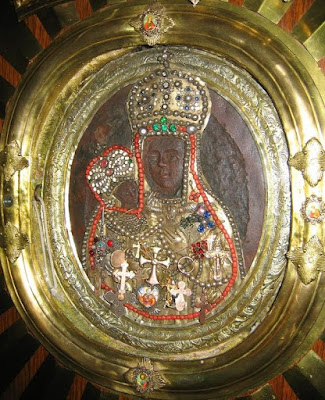 |
| Lesna Icon of the Mother of God (Feast Days - September 8 and 14) |
The Lesna Icon of the Mother of God was discovered on the Feast of the Exaltation of the Cross of the Lord in 1683 by a shepherd on the branches of a pear tree in a bright halo of light. Seized with terror, he fell on his knees and began to pray, then ran away and told his friend about what he had seen. The two of them hastened to tell the people of their village and the parish priest about the miraculous appearance. The icon was first brought to a peasant's house and then translated to the manor house of the local landowner. It became an object of veneration for numerous pilgrims. Then it was taken to a nearby Orthodox church of the village of Bukowiec, not far from the town of Lesna in Poland.
When news of the miraculously appearing icon circulated throughout all the surrounding area, the Catholic priests then decided to use the icon for spreading Catholicism. They took away the icon by force from the inhabitants of Bukowiec in 1686 and put it in the Roman Catholic church at Lesna.
At the beginning of the eighteenth century, monks of a Catholic order founded a large Roman Catholic church and monastery at Lesna, in which was the wonderworking icon. In 1863 the monks of the order took part in the Polish revolt, and, by decree of the Russian government, the monastery was closed and converted into an Orthodox women’s monastery. Many miracles were worked by the icon. By the turn of the century, the icon wrought more than five hundred miracles. The original miracle-working icon was carved from dark-red stone and set in a small silver frame and a large gilt frame in the shape of rays coming forth from it. It currently is kept at the Convent of the Lesna Mother of God Icon at Provemont in France. The celebration of the Lesna Icon of the Mother of God is celebrated also on September 8.
